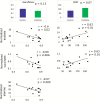Altered diurnal states in insomnia reflect peripheral hyperarousal and metabolic desynchrony: a preliminary study
- PMID: 29522222
- PMCID: PMC5946940
- DOI: 10.1093/sleep/zsy043
Altered diurnal states in insomnia reflect peripheral hyperarousal and metabolic desynchrony: a preliminary study
Abstract
Study objectives: Insomnia is a common sleep disorder that is associated with a range of adverse outcomes. Patients with insomnia exhibit hyperarousal in multiple domains, including an elevated metabolic rate, but specific metabolic molecular perturbations are unknown. Furthermore, objective clinical markers of insomnia are not available and current assessment of pathological extent relies on self-report. Here, we provide preliminary evidence that chronic insomnia is remarkably reflected in the periphery through detailed metabolic assessments.
Methods: Serum from confirmed patients with insomnia and matched good sleepers (n = 15 per group) was sampled at high temporal resolution (every 2 hr over 48 hr). Food intake was controlled by providing hourly isocaloric snacks, and sleep architecture was assessed by overnight polysomnography. Quantitative metabolic assessments were conducted using nuclear magnetic resonance spectroscopy.
Results: Global metabolic profiles differentiated patients with insomnia from healthy controls, with elevated amino acid and energy metabolites and reduced branched-chain amino acid catabolic products. Strikingly, branched-chain amino acid catabolism was found to be specifically altered during the night with ~10 per cent increased accumulation of glucose in insomnia patients. Rhythmicity analysis revealed 11 metabolites that cycled diurnally across both groups, with phase advances noted for acetone and delays for lactate and branched-chain amino acids and their products.
Conclusions: These preliminary observations suggest that insomnia is associated with quantitative metabolic dysregulation and supports the hyperarousal hypothesis. Furthermore, we posit that these changes lead to a state of metabolic desynchrony in insomnia that is involved in the pathophysiology of the disorder and/or mediates its impact on health outcomes.
Clinical trials registration: NCT01957111.
Figures






Similar articles
-
Insomnia-perchance a dream? Results from a NREM/REM sleep awakening study in good sleepers and patients with insomnia.Sleep. 2018 May 1;41(5). doi: 10.1093/sleep/zsy032. Sleep. 2018. PMID: 29432570
-
Insomnia disorder is associated with 24-hour cortical hyperarousal.Sleep Med. 2024 Dec;124:681-687. doi: 10.1016/j.sleep.2024.11.002. Epub 2024 Nov 9. Sleep Med. 2024. PMID: 39536528
-
Energetic and cell membrane metabolic products in patients with primary insomnia: a 31-phosphorus magnetic resonance spectroscopy study at 4 tesla.Sleep. 2013 Apr 1;36(4):493-500. doi: 10.5665/sleep.2530. Sleep. 2013. PMID: 23564996 Free PMC article.
-
The microstructure of sleep in primary insomnia: an overview and extension.Int J Psychophysiol. 2013 Aug;89(2):171-80. doi: 10.1016/j.ijpsycho.2013.04.002. Epub 2013 Apr 11. Int J Psychophysiol. 2013. PMID: 23583625 Review.
-
The pathophysiology of insomnia.Chest. 2015 Apr;147(4):1179-1192. doi: 10.1378/chest.14-1617. Chest. 2015. PMID: 25846534 Free PMC article. Review.
Cited by
-
Metabolomics in Sleep, Insomnia and Sleep Apnea.Int J Mol Sci. 2020 Sep 30;21(19):7244. doi: 10.3390/ijms21197244. Int J Mol Sci. 2020. PMID: 33008070 Free PMC article. Review.
-
Acupuncture ameliorates Mobile Phone Addiction with sleep disorders and restores salivary metabolites rhythm.Front Psychiatry. 2023 Feb 21;14:1106100. doi: 10.3389/fpsyt.2023.1106100. eCollection 2023. Front Psychiatry. 2023. PMID: 36896350 Free PMC article.
-
Sex differences in prevalence and clinical correlates of insomnia in Chinese patients with chronic schizophrenia.Eur Arch Psychiatry Clin Neurosci. 2023 Apr;273(3):601-611. doi: 10.1007/s00406-022-01473-x. Epub 2022 Aug 16. Eur Arch Psychiatry Clin Neurosci. 2023. PMID: 35972555
-
Treatment of Insomnia with Zaleplon in HIV+ Significantly Improves Sleep and Depression.Psychopharmacol Bull. 2021 Jun 1;51(3):50-64. Psychopharmacol Bull. 2021. PMID: 34421144 Free PMC article.
-
Decoding the nexus: branched-chain amino acids and their connection with sleep, circadian rhythms, and cardiometabolic health.Neural Regen Res. 2025 May 1;20(5):1350-1363. doi: 10.4103/NRR.NRR-D-23-02020. Epub 2024 Jun 3. Neural Regen Res. 2025. PMID: 39075896 Free PMC article.
References
-
- Organization WH. The Global Burden of Disease: 2004 Update. Geneva, Switzerland: World Health Organization; 2008.
-
- Roth T, et al. . Prevalence and perceived health associated with insomnia based on DSM-IV-TR; International Statistical Classification of Diseases and Related Health Problems, Tenth Revision; and Research Diagnostic Criteria/International Classification of Sleep Disorders, Second Edition criteria: results from the America Insomnia Survey. Biol psychiatry. 2011;69(6):592–600. - PubMed
-
- Benca RM. Consequences of insomnia and its therapies. J Clin Psychiatry. 2001;62Suppl 10:33–38. - PubMed
-
- Bonnet MH, et al. . 24-Hour metabolic rate in insomniacs and matched normal sleepers. Sleep. 1995;18(7):581–588. - PubMed
Publication types
MeSH terms
Substances
Associated data
Grants and funding
LinkOut - more resources
Full Text Sources
Other Literature Sources
Medical

